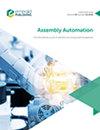Disturbance observer-based robust adaptive control for uncertain actuated nonlinear systemwith disturbances
IF 1.7
4区 计算机科学
Q3 AUTOMATION & CONTROL SYSTEMS
引用次数: 2
Abstract
The aim of this research paper is to design a disturbance observer (DO)-based robust adaptive tracking control of uncertain nonlinear system subject to unknown nonlinear disturbance.,To achieve desired control objectives, i.e. nonlinear trajectory tracking and disturbance attenuation, firstly, a control scheme is designed based on the adaptive criteria integrated in sliding mode control (SMC). In the second step, the disturbance estimation criterion is designed followed by patching with the controller obtained in the first step. Following the control development, using the Lyapunov candidate function, the stability criterion is ensured by designing appropriate adaptive gains.,In this paper, a robust adaptive nonlinear tracking method is presented. The findings includes the design of adaptive gains for the control parameters involved in the robust SMC technique, i.e. adaptive criterion is designed for the switching gain as well as for the gain used in sliding mode surface. Furthermore, a disturbance estimation criterion is developed to attenuate nonlinear disturbances with variable frequency and magnitude. Finally, the disturbance estimation scheme is combined with the control technique to obtain DO-based control (DOBC) algorithm.,Sliding mode control is a powerful robust control method. And, combining it with the DO achieves the control objectives of plants subject to disturbances and uncertainties. However, usually the uncertainties and disturbances are unknown and time varying. Thus, during practical implementation, designing the standard SMC is a challenging task due to the constant gains involved in the control design. Hence, it is important to have a criterion which adapts to the varying dynamics of plants due to the uncertainties and disturbances for achieving practical implementation of the control system.,Sliding mode control has been widely used for achieving the desired control objectives and robustness in the close-loop nonlinear systems. Besides, the SMC technique has been combined with the DOs as well. However, mostly the ideal conditions were considered during these developments, which required the control gains to be designed simply by manual tuning appropriately. However, by considering the real-time dynamics, uncertainties and disturbances, the constant control gain criteria can fail. Furthermore, due to external and internal disturbances, the model plant can vary with time. Thus, it is important to design the adaptive criteria for the control gains in DOBC schemes.具有扰动的不确定驱动非线性系统基于扰动观测器的鲁棒自适应控制
本文的目的是设计一种基于扰动观测器(DO)的不确定非线性系统在未知非线性扰动下的鲁棒自适应跟踪控制。,为了实现期望的控制目标,即非线性轨迹跟踪和扰动衰减,首先,基于滑模控制中的自适应准则设计了一种控制方案。在第二步中,设计扰动估计准则,然后对第一步中获得的控制器进行修补。随着控制的发展,使用李亚普诺夫候选函数,通过设计适当的自适应增益来确保稳定性准则。,本文提出了一种鲁棒自适应非线性跟踪方法。研究结果包括为鲁棒SMC技术中涉及的控制参数设计自适应增益,即为切换增益以及滑模面中使用的增益设计自适应准则。此外,还提出了一种扰动估计准则来衰减频率和幅度可变的非线性扰动。最后将扰动估计方案与控制技术相结合,得到了基于DO的控制(DOBC)算法。,滑模控制是一种强大的鲁棒控制方法。并且,将其与DO相结合,实现了受干扰和不确定性影响的工厂的控制目标。然而,不确定性和干扰通常是未知的,并且是随时间变化的。因此,在实际实施过程中,由于控制设计中涉及的恒定增益,设计标准SMC是一项具有挑战性的任务。因此,为了实现控制系统的实际实现,重要的是要有一个适应由于不确定性和干扰而引起的植物动态变化的标准。,在闭环非线性系统中,滑模控制已被广泛用于实现期望的控制目标和鲁棒性。此外,SMC技术也与DO相结合。然而,在这些开发过程中,大多数情况下都考虑了理想条件,这需要通过适当的手动调整来简单地设计控制增益。然而,考虑到实时动态、不确定性和扰动,恒定控制增益准则可能会失效。此外,由于外部和内部扰动,模型对象可能随时间变化。因此,设计DOBC方案中控制增益的自适应准则是很重要的。
本文章由计算机程序翻译,如有差异,请以英文原文为准。
求助全文
约1分钟内获得全文
求助全文
来源期刊

Assembly Automation
工程技术-工程:制造
CiteScore
4.30
自引率
14.30%
发文量
51
审稿时长
3.3 months
期刊介绍:
Assembly Automation publishes peer reviewed research articles, technology reviews and specially commissioned case studies. Each issue includes high quality content covering all aspects of assembly technology and automation, and reflecting the most interesting and strategically important research and development activities from around the world. Because of this, readers can stay at the very forefront of industry developments.
All research articles undergo rigorous double-blind peer review, and the journal’s policy of not publishing work that has only been tested in simulation means that only the very best and most practical research articles are included. This ensures that the material that is published has real relevance and value for commercial manufacturing and research organizations.
 求助内容:
求助内容: 应助结果提醒方式:
应助结果提醒方式:


